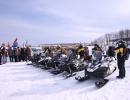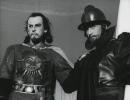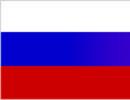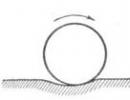Activity as a way of existence for people plan c8. Activity is a way of human existence. Main features a) Creative character b) Productive character c) Transformative character d) Social character
Topics of plans for the “Human” section
1. Man and his nature. / Biological, mental and social in man.
1. 2. Personality in the system of social relations.
2. 3. Socialization of the individual.
3. 4. Activity and its role in the formation of the human personality.
4. 5. Spiritual activity and its specificity .
5. 6. The role of cognitive activity.
6. 7. Interpersonal relationships and interactions.
7. 8. Communication and its role in personality development.
8. 9. Game and its role in the formation of human personality.
9. 10. Personality in modern society.
10. 11. Labor activity.
C8.2.1.
“Man and his nature. / Biological, mental and social in man" . Make a plan according to which you will cover this topic. The plan must contain at least three points, of which two or more are detailed in sub-points.
|
1) The essence of human nature. / Biopsychosocial nature of man. / Man is a product of the creation of nature and society. 2) Manifestations of human nature: a) biological (race, gender, age, body type, genotype); b) mental (emotions, feelings, will, memory properties, personality orientation, etc.); c) social (skills, knowledge, values, ideals, life experience). 3) Properties of temperament and their consideration in human life: a) phlegmatic; b) choleric; c) sanguine; d) melancholic. 4) The complexity of human essence: a) man as an individual; b) a person as an individual; c) a person as a person. 5) Natural inclinations are the basis for the formation of abilities. |
C8.2.2.
You are instructed to prepare a detailed answer on the topic "Personality in the system of social relations"
|
1) The concept of personality. / Personality is the subject and object of social relations. / Personality is a set of socially significant qualities. 2) The most important personality traits: a) knowledge about the world, society, oneself; b) cognitive and practical skills; c) social experience; d) moral values and ideals; e) other socially significant qualities. 3) Socialization is the process of a person’s entry into the world of social connections and interactions: a) primary socialization (family, small society, preschool education); b) secondary socialization (school, professional activity, etc.). 4) Models of interaction between the individual and society: a) constructive; b) destructive. 5) Specifics of the formation and formation of personal qualities in the modern era: a) tolerance; b) innovativeness; c) creativity; d) initiative; d) humanism. 6) Personality and society, interconnection and interdependence. |
C8.2.3.
You are instructed to prepare a detailed answer on the topic "Socialization of the individual"
|
1) The essence of the socialization process. / Socialization is the process of formation of personal qualities. / Socialization is the process of a person’s entry into the world of social connections and interactions 2) Socialization functions: a) mastering a system of knowledge about the world, man, human society; b) acquiring experience of human interaction with society; c) assimilation of moral values and ideals; d) mastering practical skills. 3) Levels (stages) of socialization: a) primary socialization; b) secondary socialization. 4) Institutes (agents) of socialization: a) family; b) immediate environment; c) education system; d) professional activity. 5) Specifics of the socialization process in the modern era. |
C8.2.4.
You are instructed to prepare a detailed answer on the topic “Activity and its role in the development of human personality”
|
1) The concept of activity. / Activity is a form of human activity. 2) Distinctive features of human activity (differences between human activity and animal activity): a) purposefulness; b) awareness; c) presentation of an ideal result model; d) transformative, creative nature. 3) Main types of human activities: a) gaming; b) educational; c) labor. 4) Spiritual and practical activities and their manifestations in society. a) spiritual activity (research, prognostic, cognitive, value-oriented); b) practical activities (material and production, social and transformational). 5) Activity and communication. 6) Activity and creativity. 7) The role of activity in transforming a person’s natural inclinations into abilities. |
C8.2.5.
You are instructed to prepare a detailed answer on the topic “Spiritual activity and its specificity” . Make a plan according to which you will cover this topic. The plan must contain at least three points, of which two or more are detailed in sub-points.
|
1) The concept of spiritual activity. / Material and spiritual activities. / Spiritual activity – production of spiritual goods. 2) Specificity of subjects and objects of spiritual activity. 3) Main goals of spiritual activity: a) formation of public consciousness; b) formation of values and ideals of a person and society; c) satisfying the ideal needs of society; d) production of spiritual goods. 4) Forms of spiritual activity: a) prognostic; b) cognitive; c) value-oriented. 5) The role of spiritual activity in the modern world. |
C8.2.6.
You are instructed to prepare a detailed answer on the topic "The role of cognitive activity"
|
1) The concept of cognitive activity./ Cognitive activity is an activity aimed at gaining knowledge. 2) Objects of cognitive activity: a) the surrounding world, nature; b) society; c) person. 3) Forms of knowledge: a) sensory knowledge b) rational knowledge 4) Cognitive activity – the path of personal self-improvement and self-development |
C8.2.7.
You are instructed to prepare a detailed answer on the topic "Interpersonal Relationships and Interactions" . Make a plan according to which you will cover this topic. The plan must contain at least three points, of which two or more are detailed in sub-points.
|
1) The concept of interpersonal relationships. 2) Distinctive features of interpersonal relationships: a) emotionally charged character; b) the direct nature of interaction and communication; c) implementation within a narrow circle of people. 3) Main areas of interpersonal relationships: a) family relationships; b) relationships among colleagues; c) relationships in a friendly company. 4) Specifics of interpersonal conflict. 5) Conditions for the effectiveness of interpersonal interaction: a) accepting a different opinion for granted; b) readiness for dialogue and mutual understanding; c) carrying out joint activities; d) commonality of goals and interests. 6) Competition and cooperation in interpersonal relationships. |
C8.2.8.
You are instructed to prepare a detailed answer on the topic “Communication and its role in personality development” . Make a plan according to which you will cover this topic. The plan must contain at least three points, of which two or more are detailed in sub-points.
|
1) Communication as a special type of human activity./ Communication is an activity carried out in the presence of a partner. 2) Basic functions of communication: a) communicative (information exchange); b) perceptual (acceptance of each other); c) interactive (interaction with each other). 3) Sociability (sociability) as a personality trait. 4) Conditions for constructive communication: a) willingness to cooperate and compromise; b) accepting a different point of view while defending your own; c) respectful attitude towards the partner. 5) Communication in play, work, study. 6) Specifics of communication in the online community: a) intensity of communications; b) virtual communication; c) abundance and diversity of information flows. 7) Communication in the formation of a modern type of personality. |
C8.2.9.
You are instructed to prepare a detailed answer on the topic “Game and its role in the formation of human personality” . Make a plan according to which you will cover this topic. The plan must contain at least three points, of which two or more are detailed in sub-points.
|
1) Game as a special type of human activity./ Game is an activity associated with the manifestation of a person’s creative abilities. 2) Basic properties of the game: a) creative character; b) the presence of an imaginary setting; c) mastering new social roles; d) the presence of certain rules. 3) Classification of games: a) role-playing (mothers and daughters, cowboys and Indians); b) situational (flying to the moon, being on a desert island); c) business (resolving a problem situation in the company); d) sports, etc.. 4) Specifics of games in childhood and adulthood. 5) Play is a necessary condition for the development of creative abilities and sociability. |
C8.2.10.
You are instructed to prepare a detailed answer on the topic "Personality in modern society" . Make a plan according to which you will cover this topic. The plan must contain at least three points, of which two or more are detailed in sub-points.
|
1) Personality is the subject and product of social relations and activities. 2) Personality traits: a) universal (timeless, characteristic of people of different historical eras); b) concrete historical (formed depending on historical conditions). 3) Specific personality traits of the modern type: a) readiness for innovation; b) adaptability to a rapidly changing world; c) creativity; d) openness, tolerant perception of new things; e) initiative and initiative; f) the ability to live and interact in a multicultural society. 4) The main factors influencing the individual in modern society: a) the system of mass communication; b) increased information flows; c) the changed nature of education and work; d) intensification of communication in the online community. 5) Intellectual development is an important condition for the effectiveness of an individual in the modern era. |
C8.2.11.
You are instructed to prepare a detailed answer on the topic "Labor activity" . Make a plan according to which you will cover this topic. The plan must contain at least three points, of which two or more are detailed in sub-points.
|
1) Labor is the activity of transforming natural substances. 2) Signs of work activity: a) practical nature (satisfying material needs); b) transformative nature (transformation of forces and substances of nature); c) creative nature (creation of something new that has no analogues). 3) Main types of labor: a) physical and mental; b) simple and complex. 4) Specifics of labor activity in modern society: a) the complex nature of the work; b) knowledge intensity, intellectual work; c) technological effectiveness of labor, reducing the scope of simple physical labor. 5) The role of labor in the development of personality and the formation of a team: a) development of communication skills; b) development of thinking and creativity; c) developing the ability to act outside the box; d) developing the ability to cooperate in achieving a joint goal; e) formation of a cohesive and effective team. 6) Labor is the basis of the well-being of society. |
In the course of his life, a person always acts. He studies the world around him, creates conditions for his existence, and learns new things. Let's try to find the answer to this question and briefly study the topic of grade 10, “Activity is a way of human existence.”
Human activity
Both people and animals constantly act, but human activity has a number of distinctive specific features :
- It is of a conscious nature: a person understands why he is doing this or that business, can set goals, change types of activities;
- Aimed at obtaining a result, a product of activity;
- In its process, a person transforms both himself and the world around him;
- A person is constantly in contact with other people.

Need
Everything a person does is aimed at satisfying his needs.
They are divided into groups:
- natural (food, air, shelter, etc.);
- social (work, creativity, communication);
- spiritual (knowledge of the world, self-expression).
Psychologists (A. Maslow, S. L. Rubinstein, A. N. Leontiev and others) agree that a person cannot achieve complete satisfaction of needs. This is well illustrated by the tale of A.S. Pushkin’s “Goldfish”: the old woman, having received a new trough, wanted a hut, and then a tower, and she had more and more desires.
Human activity is planned.
- target
When implementing an activity, a person imagines in advance what he wants to achieve. For example, a tailor, when creating a thing, imagines how it will look.
- facilities
In order to accomplish this, special means are needed. For example, to write an essay you will need paper and pen or a computer, as well as books and textbooks on the chosen topic.
- result
The goal is embodied in results. These could be things, relationships, skills, and so on.
TOP 4 articleswho are reading along with this
Motive
Why do people set goals? What makes them engage in any activity. What motivates people to act is called motive.
You can engage in the same activity, but have different motives. For example, three students complete all their homework, follow the teacher’s advice, and carefully study all the rules. But for one of them it is important to get only good grades, the second student is afraid of upsetting his parents, and the third is actually interested in learning new things.
Activities
There are many types of activities, so for clarity they usually divided into groups :
- in relation to the surrounding world: practical and spiritual;
- by contribution to the development of society: progressive and regressive, creative and destructive;
- according to current standards: legal and illegal, moral and immoral;
- by the form of association with other people: collective and individual;
- in the sphere in which it is implemented: political, economic, social;
- according to the degree of originality and introduction of new things: template and creative.
Personality and activity
Depending on age, a person engages in a certain type of activity.
In science, they are usually distinguished into three:
- game (the child learns the world around him and the rules through various games);
- teaching (at school children carry out educational activities);
- labor (a person works, creates some things or benefits)
At all these stages, communication also occurs - an indispensable attribute of human life.
What have we learned?
Activity is a way of existence of people, with the help of which they satisfy their natural, social and spiritual needs. Activity always has a motive, goal, means and result.
Test on the topic
Evaluation of the report
Average rating: 3.9. Total ratings received: 476.
The first part gave a general description of this task, and also proposed a universal template for its implementation. But the message did not take into account two important factors:
- There are different types of plans
- There are different models of C8 tasks.
This message will fill this gap.
The message uses materials from demo versions, tasks from the open segment of the Federal Test Bank, materials for training experts of regional subject commissions of the Unified State Exam in Social Sciences, posted on the website of the Federal Institute of Pedagogical Measurements, as well as the following sources:
- Markin S.A. Unified State Exam. Social science. Completing tasks of part S. - M.: Iris-press, 2012
- Rutkovskaya E.L., Kotova O.A., Liskova T.E. Excellent student in the Unified State Exam. Social science. Solving complex tasks/FIPI. - M.: Intellect-Center, 2010
Plan- a clear, consistent presentation of parts of the content of the studied question (or text) in brief formulations reflecting the topic and/or main idea of the corresponding fragment, the variety of its semantic connections.
There are several types of plan: title, question and thesis. Name plan consists of social science concepts and elements of their content, which are usually indicated in subparagraphs. Question plan is a list of questions, answering which the speaker reveals the content of the topic. The subparagraphs indicate the content elements of the answer to the questions. Thesis plan consists of theses of the verb structure. A thesis is a briefly formulated main position of a paragraph of text, lecture, report, etc.
There are two types of task C8.First variety involves drawing up a response plan on any one aspect of a broad topic. In this case, it is advisable to start with the disclosure of the broader concept, and then move on to the aspect that needs to be considered.
Example.
C8. You will have to prepare a detailed answer on the topic “Contradictions of social progress.” Make a plan according to which you will cover this topic. The plan must contain at least three points, of which two or more are detailed in sub-points.
In this case, the topic on which a plan is to be drawn up contains two concepts: “social progress” and “contradictions of progress.” A broader concept is the concept of “social progress”, because Contradiction is one of the properties of social progress. Consequently, it is with the concept of “social progress” that one should begin to reveal the topic outlined in the assignment. Depending on the chosen form, the plan may have several types.
Nominal form
You can use the platform on which the plan was created to edit it and, if necessary, subsequently save it.
Question form plan for the disclosure of this topic.
1) What is social progress?
2) What are the reasons for progressive changes in society?
3) In what forms can social progress take place?
a) Evolutionary
b) Revolutionary
4) What are the manifestations of the main contradictions of progress?
a) Nonlinearity.
b) Relativity.
c) Ambiguity of consequences.
d) The price of progress.
5) What are the criteria for progress?
Thesis form plan for the disclosure of this topic.
1) Social progress is understood as the development of humanity towards a better, more perfect state.
2)
The reasons for social progress are needs, during the implementation of which people change the conditions of existence and themselves.
3)
There are evolutionary and revolutionary paths of social progress.
a) Evolution is one of the forms of movement, development in nature and society, based on continuous, gradual qualitative change.
b) Revolution is one of the forms of movement, development in nature and society, based on a radical, sharp, abrupt transition from one qualitative state to another.
4) The inconsistency of progress is due to different rates of development of both different components of social life and different countries.
a) The progress of humanity does not look like an ascending straight line, but like a broken line, which reflects ups and downs, periods of positive changes and retrograde movements.
b) Individual changes simultaneously occurring in society can be multidirectional: progress in one area may be accompanied by regression in another.
c) Progressive changes in one area or another often had, along with positive, also negative consequences for society.
d) Accelerated progress was often paid at too high a price, when entire generations of people were sacrificed to progress.
5) In modern social scientific thought, the criterion of social development is the quality of life - a complex criterion that includes the level of development of productive forces, social institutions, welfare, freedom and the possibility of creative development, knowledge, and the spiritual and moral state of society.
Second variety task C8 involves drawing up a plan for an answer on any narrow topic, without the presence of generic and specific concepts in its formulation.
Example.
C8. You will have to prepare a detailed answer on the topic “Activity as a way of existence for people.” Make a plan according to which you will cover this topic. The plan must contain at least three points, of which two or more are detailed in sub-points.
In this case, there is no need to first consider a broader topic and then specify it. Therefore, the first point of the plan can be immediately set to “the concept of activity.”
Depending on the chosen form, the plan may have several types.
Nominal form plan for the disclosure of this topic.
Question form plan for the disclosure of this topic.1) What is activity?
2) How do human activities differ from the activities of other living beings?
3) What are the elements of the activity structure?
a) subject;
b) object;
Differences between human activity and animal behavior Man Not only adaptation, but also transformation of the natural and social environment. Not only adaptation, but also transformation of the natural and social environment. Not only expediency, but also goal-setting, the ability to go beyond experience. Not only expediency, but also goal-setting, the ability to go beyond experience. Other living beings Adaptation to existing natural conditions. Adaptation to existing natural conditions. Purposeful behavior guided by instinct. Purposeful behavior guided by instinct.

Activity is a way of relating a person to the outside world, characteristic only of people. The main content of the activity is to change and transform the world, to create something that does not exist in nature. Human activity manifests itself in various spheres and has a diverse nature. It is an indispensable condition for the existence and development of man and society.




A goal is something one strives for. A conscious image of the anticipated result. The desire to achieve a goal predetermines the choice of appropriate means and the sequence of specific actions to achieve it. The desire to achieve a goal predetermines the choice of appropriate means and the sequence of specific actions to achieve it.

The means of achieving the goal are techniques, methods of action, money, tools, objects, devices for carrying out activities. The wider the set of means that the subject of an activity owns, the more opportunities there are to carry out this activity by choosing suitable means. The wider the set of means that the subject of an activity owns, the more opportunities there are to carry out this activity by choosing suitable means.

Actions aimed at achieving a goal are an external manifestation of volitional effort, which is opposed to a passive and indifferent state. M. Weber divided actions into 4 groups: - Purposive action (rationally set, thoughtful goal); -Value-rational action (conscious determination of one’s direction); -Affective action (determined by the emotional state of the individual); -Traditional action (based on long-term habit).

The result of the activity does not always correspond to the goal. Reasons: - A deliberately unattainable goal; -Insufficient consideration of external conditions of activity, possible obstacles, difficulties; -Wrong choice of means to achieve the goal; - Inept implementation of actions necessary to achieve the goal.



Maslow's pyramid Groups of needs: -Physiological (food, breathing, housing, clothing); -Existential (safety, comfort, employment); -Social (communication, affection, joint activities); -Prestigious (self-esteem, recognition, career growth); -Spiritual (self-expression). Physiological and existential are primary (congenital), social, prestigious and spiritual are secondary (acquired).






4 groups of actions depending on motives (Max Weber) 1. Purposeful action - a rationally set and thoughtful goal. 1. Purposeful action - a rationally set and thoughtful goal. Value-based and rational action is a conscious determination of direction and a consistently planned orientation to action. Value-based and rational action is a conscious determination of direction and a consistently planned orientation to action. Affective action is the emotional state of an individual. Affective action is the emotional state of an individual. Traditional action - based on a long habit Traditional action - based on a long habit

Activity includes the Conscious – Conscious – the comprehension of the objective world and one’s own existence, which determines and regulates activity. the meaningfulness of the objective world and one’s own existence, which determines and regulates activity. Unconscious is an action performed automatically, reflexively, without awareness by the subject. Unconscious is an action performed automatically, reflexively, without awareness by the subject.


Classification of activities: Practical – Practical – aimed at transforming real objects of nature and society. is aimed at transforming real objects of nature and society. -Material-production (transformation of nature) - Social-transformational (transformation of society) Spiritual - Spiritual - aimed at changing the consciousness of people. - Cognitive (reflection of reality in artistic and scientific form, in myths and religious teachings) - Value-oriented (determining people’s attitudes to the phenomena of the surrounding world, forming a worldview) - Forecasting activity (planning or anticipating possible changes in reality)


Creative activity is an activity that generates something qualitatively new (a new goal, a new result, new means of achieving results). activity that generates something qualitatively new (a new goal, a new result, new means of achieving results). Mechanisms of creative activity: imagination, imagination, fantasy - reflection in the human mind of the phenomena of reality in new, unusual, unexpected combinations and connections. fantasy is a reflection in the human mind of the phenomena of reality in new, unusual, unexpected combinations and connections. intuition is knowledge, the conditions for obtaining which are not realized. Intuition reveals the unconscious in human activity. But the intuitive in creativity is associated with conscious effort. intuition is knowledge, the conditions for obtaining which are not realized. Intuition reveals the unconscious in human activity. But the intuitive in creativity is associated with conscious effort.


A game is a meaningful activity, a set of meaningful actions united by a unity of motive. meaningful activity, a set of meaningful actions united by the unity of motive. Focused not only on the result, but also on the process itself. The peculiarity is the two-dimensionality: on the one hand - real action, on the other - convention, action in an imaginary setting



Types of communication: communication between real subjects (between two people) communication between real subjects (between two people) communication between a real subject and an illusory partner (between a person and an animal) communication between a real subject and an illusory partner (between a person and an animal) communication between a real subject with an imaginary partner (a person with his own inner voice); communication of a real subject with an imaginary partner (a person with his inner voice); communication of imaginary partners (communication of literary characters). communication of imaginary partners (communication of literary characters).


It is necessary to be able to distinguish communication from communication. Communication is the process of interaction between two or more entities with the purpose of transmitting some information. The transfer of information occurs only in the direction of one of the subjects and there is no feedback between the subjects. Communication is the process of interaction between two or more entities with the purpose of transmitting some information. The transfer of information occurs only in the direction of one of the subjects and there is no feedback between the subjects.

Concepts of the topic that need to be remembered: Activity Spiritual activity Game Interests Intuition Communication Motives Communication Object of activity Needs Practical activity Social attitudes Subject of activity Creative activity Labor activity Beliefs Fantasy







